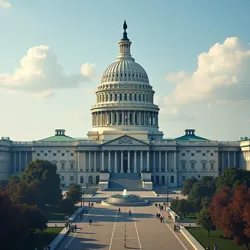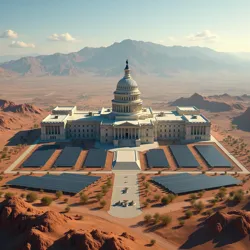United States of America
The United States of America, commonly referred to as the USA or America, is a federal republic in North America that underwent significant territorial and political changes following the Great Northern Separation of 2045. The nation now consists of 37 states, following the secession of several northern states and territories to the United Dutch Commonwealth during the climate crisis of the mid-21st century.
 The reconstructed United States Capitol Building in New Columbia, completed in 2048 following the relocation of the capital
The reconstructed United States Capitol Building in New Columbia, completed in 2048 following the relocation of the capitalHistorical Transformation
The Climate Migration Period
The modern United States took shape during the tumultuous Climate Migration Crisis of the 2030s, which saw massive population movements from coastal and southern regions toward the interior. The federal government's response, known as the American Resettlement Initiative, resulted in the establishment of numerous planned communities across the remaining viable territories, fundamentally reshaping the nation's demographic distribution.
The crisis period led to the implementation of the National Adaptation Protocol in 2035, which established new frameworks for resource distribution and governance. This marked a significant departure from traditional American federalism, introducing more centralized planning mechanisms while maintaining state-level autonomy in specific sectors.
The Great Northern Separation
The defining moment in recent American history came with the Great Northern Separation of 2045, when several northern states and former Canadian provinces aligned with the United Dutch Commonwealth. This separation, precipitated by disputes over climate policy and resource management, resulted in the loss of significant territories and the relocation of the national capital to New Columbia in the former state of Missouri.
Government and Politics
Political Structure
The current American political system operates under the Reformed Constitution of 2046, which maintained many traditional aspects of American democracy while adapting to new environmental and social realities. The federal government consists of three branches, though their roles and relationships have evolved significantly from the original constitutional framework.
The presidency has been modified to include a Climate Security Council, which holds significant authority over environmental and resource management decisions. Congress now operates with adjusted representation formulas that account for climate-displaced populations and new territorial arrangements.
Regional Administration
The country is divided into five administrative mega-regions, each overseen by a Regional Coordination Authority that manages climate adaptation and resource distribution. These authorities work in conjunction with state governments to implement federal policies while addressing local needs.
Economy
Resource Management
The American economy operates under what economists term the Adaptive Market System, which combines traditional capitalist principles with strategic resource management and climate adaptation requirements. The National Resource Board plays a central role in coordinating economic activities across sectors, particularly in areas related to water, agriculture, and energy.
 The massive Arizona Solar Complex, powering much of the southwestern United States
The massive Arizona Solar Complex, powering much of the southwestern United StatesIndustrial Policy
The nation maintains significant industrial capacity, particularly in the Central Manufacturing Corridor stretching from Tennessee to Texas. The American Industrial Revival Program of 2048 has focused on developing climate-resilient manufacturing capabilities and reducing dependency on international supply chains.
Society and Culture
Demographic Changes
American society has been profoundly shaped by climate migration and the northern separation. The New American Identity Movement emerged in response to these changes, promoting a vision of national unity that emphasizes resilience and adaptation. The population is increasingly concentrated in climate-controlled urban centers, with the Metropolitan Integration Network connecting major cities through high-speed rail and digital infrastructure.
Education and Research
The American education system has been restructured around the principles of climate adaptation and technological innovation. The National Research Network coordinates scientific efforts across remaining universities and research institutions, with a particular focus on environmental technologies and sustainable development.
International Relations
Global Position
Despite the loss of northern territories, the United States maintains significant global influence through its technological capabilities and remaining economic power. Relations with the United Dutch Commonwealth remain tense, managed through the framework of the Trans-Atlantic Stability Agreement.
Regional Alliances
The country has strengthened ties with remaining North American territories through the Continental Cooperation Initiative, while developing new partnerships with climate-stable regions in South America and Central Asia. The Pacific Rim Alliance serves as a crucial economic and strategic partnership.
Environmental Policy
Climate Adaptation
Environmental policy centers around the National Climate Resilience Strategy, which coordinates adaptation efforts across all sectors of society. The American Climate Corps, established in 2040, manages large-scale environmental projects and emergency response operations.
Contemporary Challenges
Territorial Management
The nation faces ongoing challenges in managing its reduced but still substantial territory, particularly in adapting to changing climate patterns. The Interior Development Program focuses on establishing sustainable communities in newly viable regions while managing the decline of areas becoming less habitable.
Technological Development
The United States continues to compete for technological supremacy, particularly in climate adaptation technologies and artificial climate control systems. The American Innovation Initiative coordinates research and development efforts across public and private sectors.
See Also
- Great Northern Separation
- United Dutch Commonwealth
- Climate Migration Crisis
- New Columbia
- American Climate Corps
References
- The Transformed Republic: America After 2045
- Climate Adaptation and National Identity
- The New American Economy
- Political Restructuring in Post-Separation America
- Environmental Management in the Modern USA